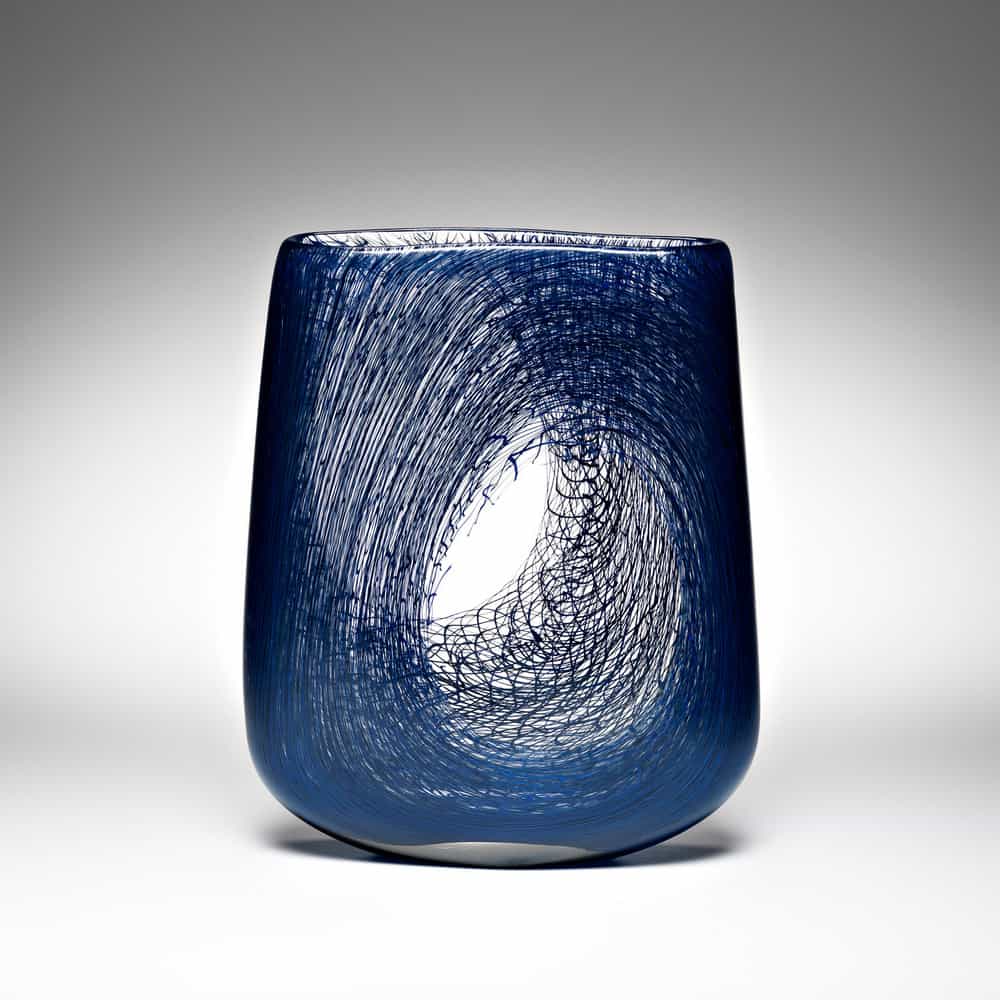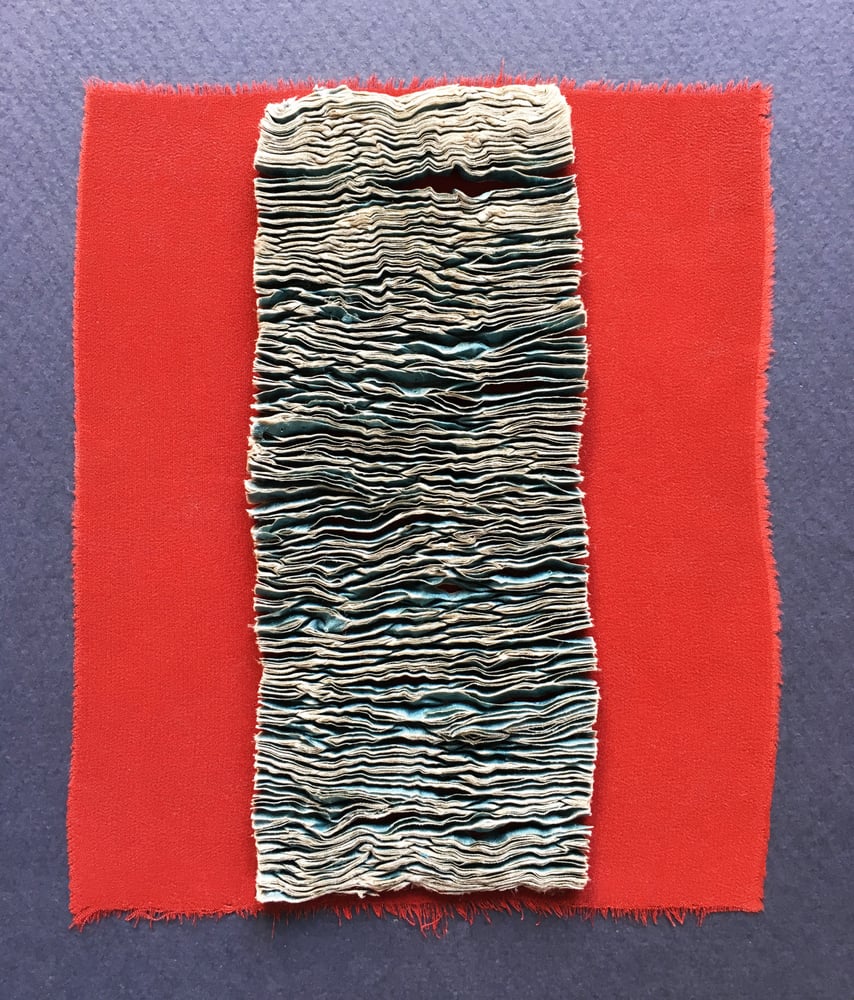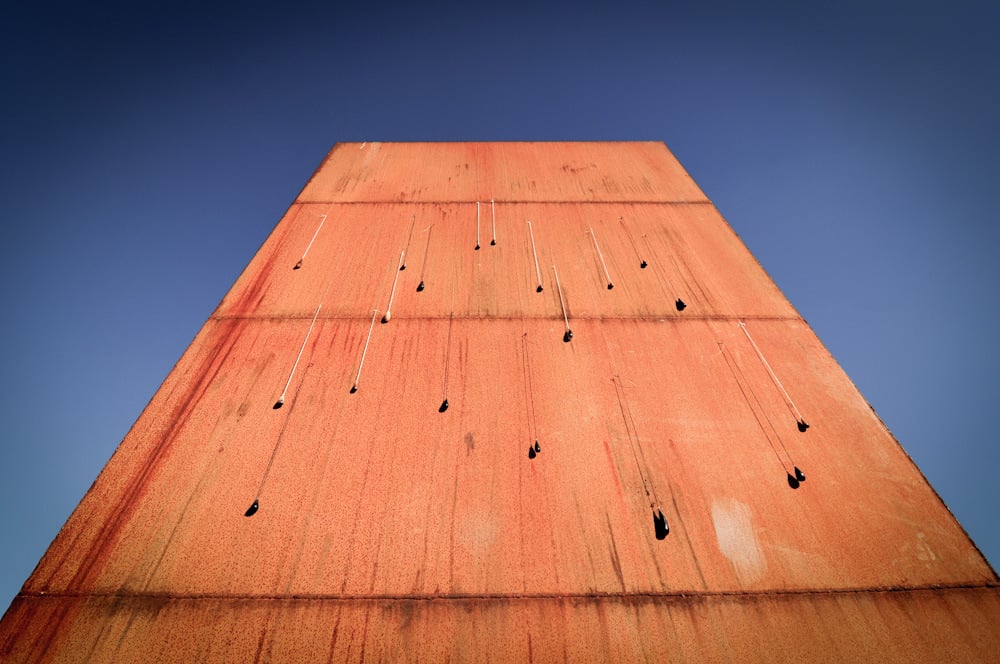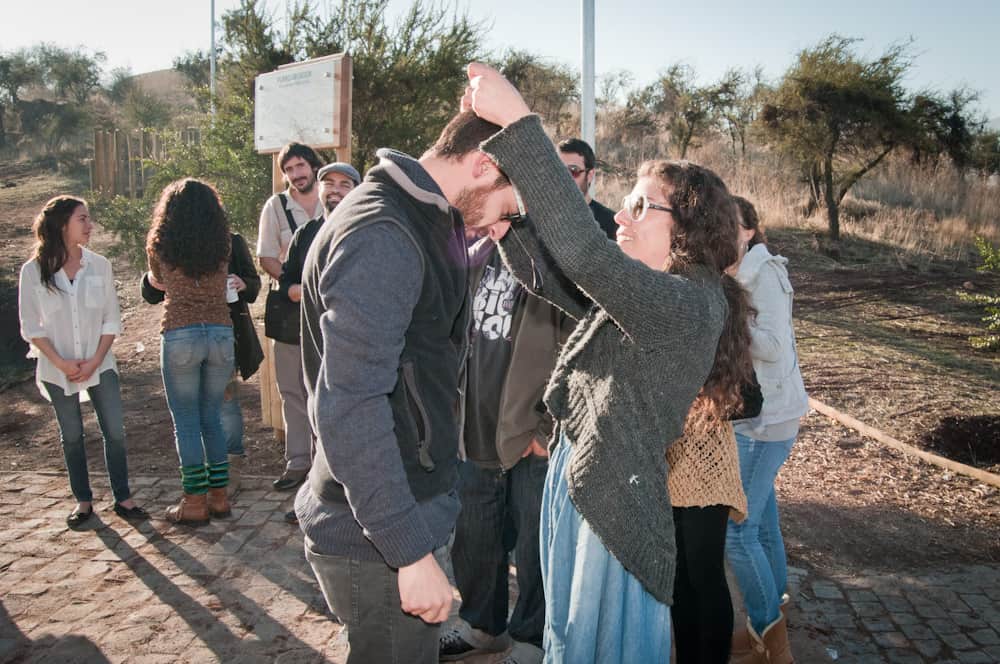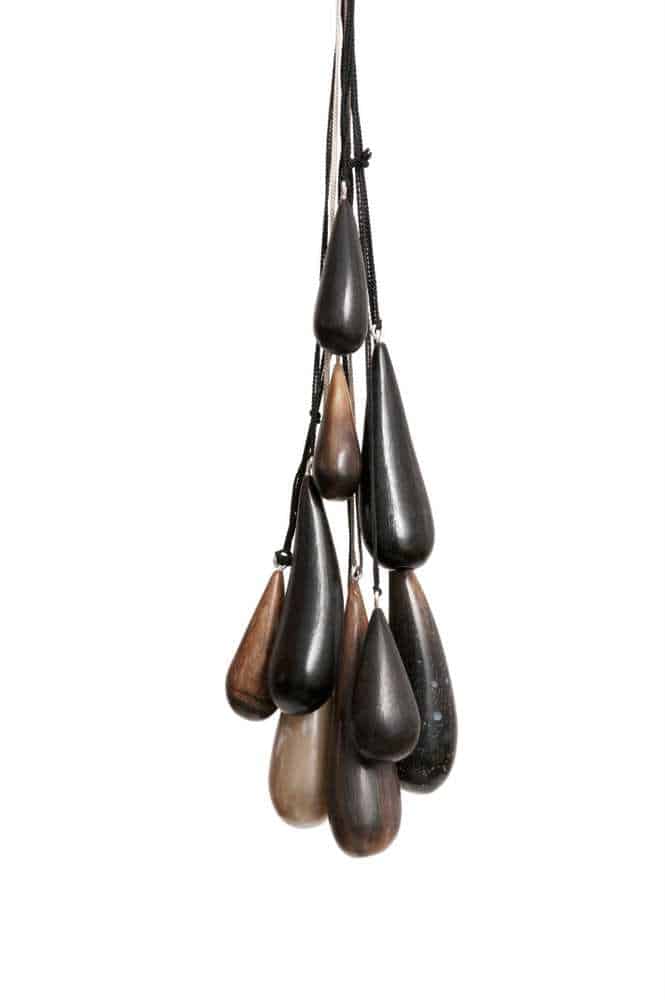The miniature deploys to the dimensions of a universe. Once more large is contained in small.
Gaston Bachelard Poetics of Space (Beacon Press, Boston MA USA, 1958, translated 1964).
The first online exhibition collects together craft objects that contain in their smallness, feelings of vastness. There is an intertwined relationship between the intimacy of work on a miniature scale and the immensity of the imaginings and dreams provoked by them. You can see an overview of the exhibition here. See below for relates images and texts for each of the artists: Susan Robey | Ian Mowbray | Rosa Hawker | Varuni Kanagasundaram | Damien Wright | Anna Gray | Andrew Stinear | Nalda Searles | Amelina Trainor | Andrew Baldwin | Andrea Mina | Caroline Baum | Clare McCracken | Vicki Mason | Julie Blyfield | Elizabeth Shaw | Paola Moreno | WALKA | this.means.that studio | Melissa Cameron | Trudy Golley | Inup Park | Juree Kim
Susan Robey
Susan Robey’s complex images are held together through an appeal to architectural space, to a discourse regarding inside and outside, where an object can be defined through the boundary between the one kind of space and the other. Robey’s objects play with this boundary. As vessels they are hollow by deduction, being ceramic but light to lift; they are bags because they are the right size and texture, with a shape that indicates they have only just been emptied. As buildings, a further poetic device takes over. The objects are models of the kind that suggest interiors which are miniature, intricate, but also Babylonian and void. Robey’s fusion of types is her individual invention, yet the imaginary world that these objects propose is a social one, of the body corporate, of the institution. As buildings, these objects have one floor over far too many columns and far too many windows under one roof for an individual’s dwelling. Seen as animals, one senses a bilateral symmetry and also a direction of movement in these pieces, both in the body and the legs under it, which again are too many, suggesting a complex organism. Seen as vessels, they are impenetrable, light and empty; despite their domestic scale, they do not imply personal, secretive interiors. Further, the objects gain by being set up in groups – cities and herds appear. Drawing inspiration from the built environment, Robey handbuilds idiosyncratic ceramic objects which bring together her understanding of architectural structure and form, and the expressive potential of clay pushed to its technical limits. With soft pliable cast paperclay slabs, Robey constructs thin-walled finely detailed objects with the lightness of crushed paper but the solidity of buildings. Clay is skilfully manipulated to explore mass and scale in both form and texture. Each work is a hybrid of architectural elements and details intentionally abstracted and suggestive of multiple sources and interpretations. Shelter alludes to the fundamental protective purpose of architecture. Shelter also refers to the implied relationship within the work: a bond between the two parts. Susan Robey is a ceramic artist and architect based in Melbourne, Australia.
Ian Mowbray
- Ian Mowbray, Stopped, hand carved glass, glass domes, glass snow, water, 120mm diameter x 80mm height, photo: David Mcarthur
- Ian Mowbray, Oh! I hope that’s not for me, hand carved glass, glass domes, glass snow, water, 120mm diameter x 80mm height, photo: David Mcarthur
- Ian Mowbray, Oh! I hope that’s not for me (detail), hand carved glass, glass domes, glass snow, water, 120mm diameter x 80mm height, photo: David Mcarthur
Dead country: To die in nature is an honourable death. You are taken apart by the ants and stored away for winter.
- Ian Mowbray, My brother, hand carved glass specimens, Chinese specimen jars, water, 90mm diameter, 180mm height, photo: David Mcarthur
- Ian Mowbray, My father’s aorta, hand carved glass specimens, Chinese specimen jars, water, 90mm diameter, 180mm height, photo: David Mcarthur
Family Souvenirs: Instead of photographs, my family collects discarded body parts of relatives as a souvenir. I am the custodian of this special collection, and these two specimens are very precious to me. The aorta was the cause of my father’s death and my brother was a stillbirth.
Rosa Hawker

Rose Hawker, Repetition to weaken the absence (detail), bronze and limestone 12 x 7 x 4cm (approx.), photo: Rose Hawker, made in Melbourne
The work try’s to deal with the feeling of loss and absence by taking something difficult to deal with and rather than blocking it out and ignoring it, repeating it over and over (there are 30 miniature horses all together). This came from the sensation of when you repeat a word over and over, it begins to lose all meaning. The work is miniature because of its personal and sensitive subject matter and was part of a larger body of work created through research into counter-monuments. The bronze was cast at Coates studio Foundry, Northcote and the limestone carved at home in Windsor. Website: http://rosehawker.wix.com/rosemsh
Varuni Kanagasundaram

Varuni Kanagasundaram, Homeland of the ‘In-Betweens’ , porcelain slip, fabric, thread, stain, glaze, 30 x 30 x 14cm photo: Jeremy Dillon, made in Melbourne
The Homeland of migrants from the Indian subcontinent living in the West is translated through textile in clay, the precarious nature of ‘moving in-between cultural traditions’ symbolically represented in the fragile ceramic thread that hangs between the steps. Website http://www.varunik.com
Damien Wright
- Damien Wright, Pama, ancient red gum, Japanese oak and celery top pine, 1000 x 500 x 400mm
- Damien Wright, Pama, ancient red gum, Japanese oak and celery top pine, 1000 x 500 x 400mm
- Damien Wright, Pama, ancient red gum, Japanese oak and celery top pine, 1000 x 500 x 400mm
- Damien Wright, Pama, ancient red gum, Japanese oak and celery top pine, 1000 x 500 x 400mm
- Damien Wright, Pama, ancient red gum, Japanese oak and celery top pine, 1000 x 500 x 400mm
It is a memory or ancestor box. It is a collaboration with my friend architect Patrick Ness. Patrick’s mothers father was a member of the Canadian army when Hong Kong fell to the Japanese in WW2. Wounded he was sent to a prison hospital. Gravely ill he asked a British soldier in the bed next to him ‘Should I die can you take my letters back to my wife and children in Canada.’ The British soldier agrees. The Canadian soldier dies. When the war is over the Brit is repatriated to Hong Kong then discharged. As soon as he is discharged he heads to Canada to deliver the correspondence as he promised. He meets and falls in love with the woman Patricks Grandmother. They court and marry and return to Hong Kong. He becomes the much loved patriarch of a growing family and Patricks grand father. Patrick could not pronounce Grandfather as a child but called him ‘Pama’. The box holds the letters and medals of both men and over 100 water line model ships that Patrick’s Pama collected. Black and impenetrable from the outside expressive and expansive inside.It has two simple locks that require intimacy to access the interior. Once you know the moves the past opens up.
Anna Gray

Anna Gray, ‘Galaxy One’ earrings, fine silver granulation with sterling silver findings, 23.5×12.5 x 0.6-3mm, made in Melbourne, photo: Anna Gray
In our universe there are infinite iterations: a scatter of granules across a surface fuses tradition with the present; fractions of element from the universe re-form to echo that larger whole. Part intent, part accident: reiteration. Website: Annagrayjewellery.com
Andrew Stinear

Andrew Stinear, 35mm Film camera circa 25 BGE (Before Google Era), lost wax cast Sterling Silver, 20 x 30 x 22mm, made in Sydney, Australia, photo: Andrew Stinear
A hand carved, scale model of the camera I used as an adolescent to capture intimate moments and memories… everything is smaller now. Website: www.andrewstinear.com
Nalda Searles
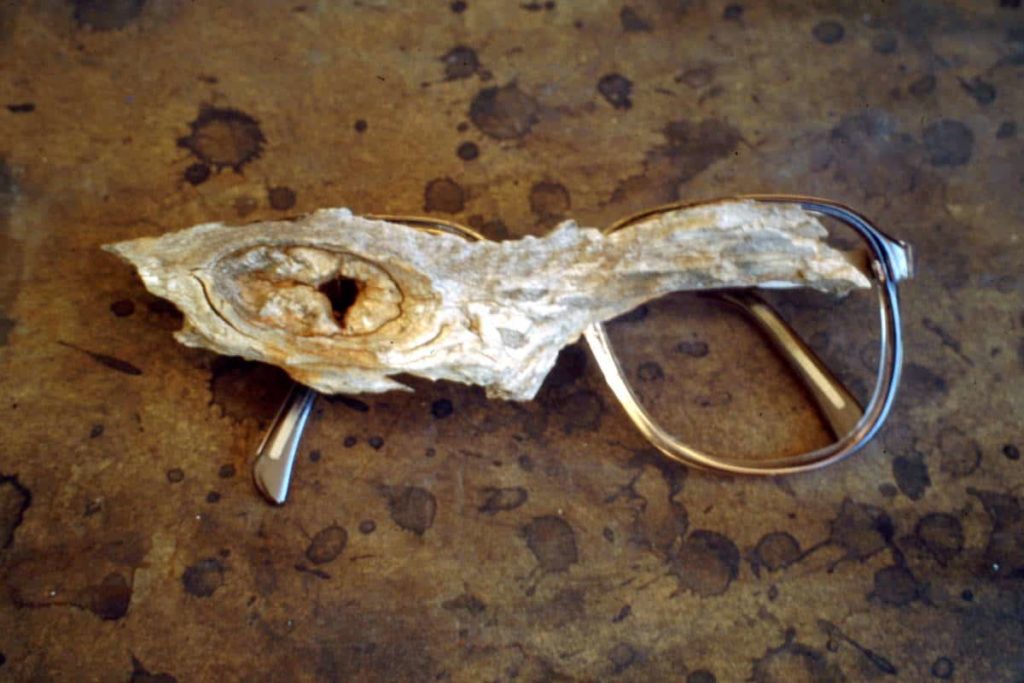
Nalda Searles, Another way of seeing, eyeglasses, aged mallee wood fragment found and collected from the West Australian Goldfields, 120mm x 60mm x 12mm
This object encourages multi-directional viewing, each is compatible and yet vastly different. “Undoubtedly the works in Searle’s re-coverings are a personal tribute to the way landscape nurtures and protects without our even being aware of it or properly appreciative, and they are descriptive of the way this particular artist perceives the interface between Aboriginal and non-Aboriginal people in her native Western Australia. As such they (the works) stand testimony to the regenerative and inherently healing qualities of participation mystique that mythical oneness and merging that unity reality we have not yet experienced collectively in Australia. The artist whose creative process is born of unsatisfied yearning is able to reach back into the unconscious and find whatever is best fitted to compensate the inadequacy and one-sidedness of the present. In this way the timeless archetypal image can take its place within current consciousness: elaborated and reshaped, translated into the language of the present. Whoever brings forth the experience of such images ‘speaks with a thousand voices, enthrals and overpowers, while at the same time lifting an idea out of the occasional and transitory into the realm of the ever enduring.'” Jenny Albertson Nussinvov, essay for Recoverings (1996)
Amelina Trainor
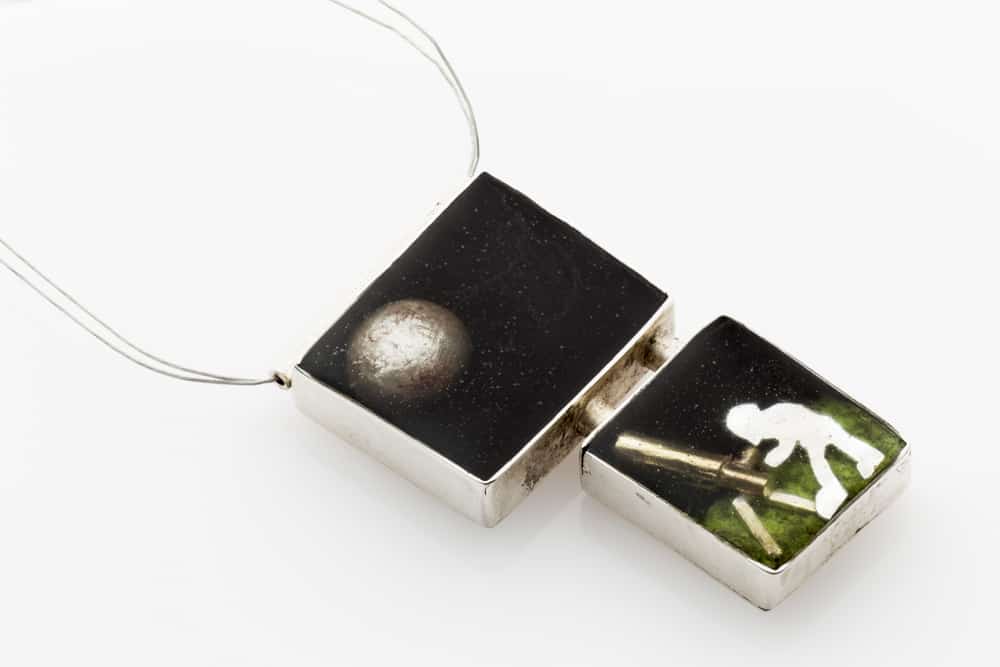
Amelina Trainor, Moongazer, Sterling Silver, brass, polymer clay, polyester resin, 2.5 cm width x 3cm height x .5 cm depth, made in Brisbane, photo: Lisa Brown
This pendant celebrates early space explorers, the earthbound who dreamed that we were part of something bigger.
Andrew Baldwin
- Andrew Baldwin, Mini void 3, blown glass H 14 x W 19 x D 4cm, made in South Australia, photo Michael Haines
- Andrew Baldwin, Mini void 4, blown glass, H 14 x W 19 x D 4cm, made in South Australia, photo Michael Haines
- Andrew Baldwin, Mini void 5, blown glass H 14 x W 19 x D 4cm, made in South Australia, photo Michael Haines
‘Void’ was first conceived while staying on a remote farm in the Mallee district of South Australia- a beautiful and arid part of Australia that is characterized by small, drought tolerant Eucalyptus trees. ‘Void’ is a miniature investigation of the sense of spaciousness.
Andrea Mina
- Andrea Mina, thirty nine, balsa wood, seaweed pods, seed pods, banksia stamens, pva glue, 94mm high, photo: Yolande Mina
- Andrea Mina, fourty, carved wood, butterfly wings, sea-urchin spine, pva glue, 29mm high, photo: Yolanda Mina
‘intimate immensity’. These words encapsulate some of the core issues underpinning the research; the allure exuded by small objects, and their provocations of reverie, where very close proximities between subject and artefact are required for there to be any meaningful engagement with the actual, material outcomes of the making. Through this compression, space and relationships are thickened, engendering intimate connections between the two. The ideas of intimacy are further enhanced by the very small sizes of the fabricated architectures.More pertinent is the aspiration of the works to transcend themselves, not by asking for meaning or translation and interpretation of their own forms, but rather to inspire and provoke very personal and individual imaginings/dreams by each who would encounter them.” Website www.andreamina.com.au
Caroline Baum
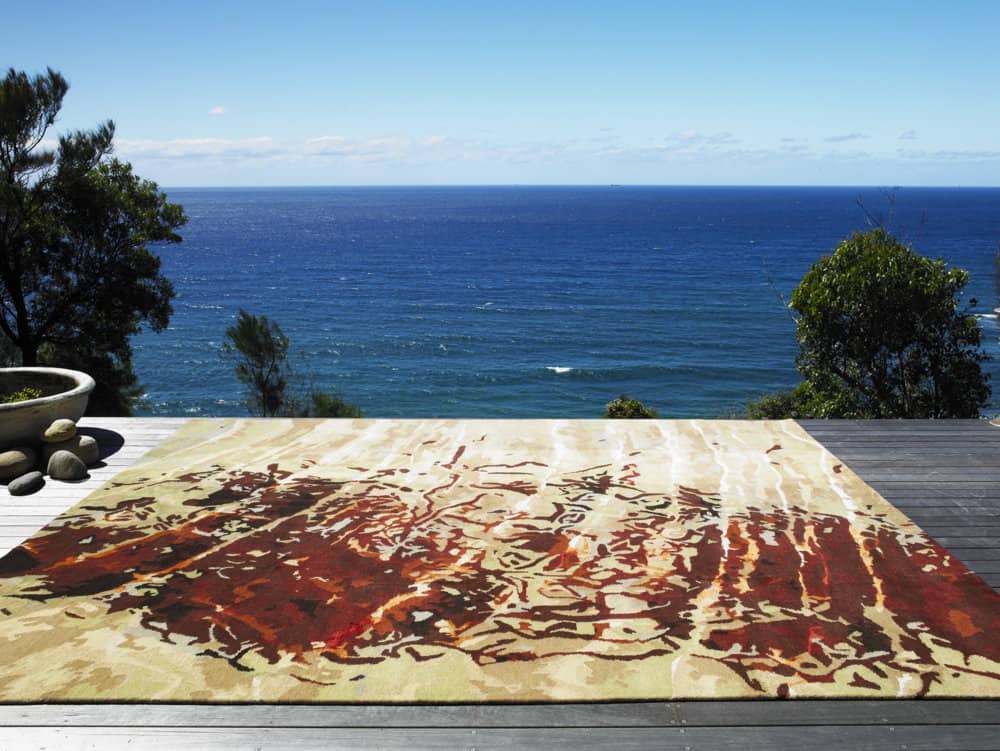
Caroline Baum, Red ripple, wool and silk, original photo of snail patterns shot in Wombarra NSW, Australia; rug
interpretation woven in Nepal, 3.2 x 2 metres, photo: Tim Robinson
The rug is a hand-knotted interpretation of my image of the patterns created by sea snails on a rockshelf,the red is the true colour created by the presence of iron in the rock. I love the way the world of these tiny creatures a map of songlines across the sandy watery terrain of tessellated stone, becomes a bigger abstract landscape. websites: www.carolinebaum.com.au www.designerrugs.com.au
Clare McCracken
The White Building is a cultural complex in a medium density apartment complex for working class Cambodians in Phnom Penh, Cambodia. The single greatest issue facing the residents is housing security. As Cambodia rapidly urbanises, it is the urban poor that are forcibly removed from their homes to make way for shiny new apartment towers they cannot afford. During a residency at the building, Clare McCracken chatted to the residents about their housing concerns and asked them to teach her how to cross stitch. The cross stitching of pictorial tapestries was a popular hobby during her stay and an effective way to connect with the residents. Moving away from the images provided in the tapestry kits, Clare stitched the grates, bricks and vents that residents had added to the building to make it an effective home. She then gifted these small bespoke tapestries to some of the residents she got to know as a memory of the home and community they may be forced to leave shortly.
Vicki Mason
- Vicki Mason, Pink corona cluster
- Vicki Mason, Whorling sprouting corona
Julie Blyfield
- Julie Blyfield, Moonlit spinifex containers, oxidised sterling silver, wax, 2015
- Julie Blyfield, Eucaplyptus brooch, oxidised sterling silver, wax, 2015
- Julie Blyfield, Quandong container, oxidised sterling silver, wax, 2015
- Julie Blyfield, Saltbed brooch, sterling silver,2015
Elizabeth Shaw

Elizabeth Shaw, Braced figure, Recycled and reused sterling silver, found ceramic, dolls hair, 8 x 2.5 x 3 cm pendant, 2015, made in Brisbane, photo: Michelle Bowden
My works start with a collected or found broken part of an object that brings with it a history. I embellish the history through additions of other elements.
Paola Moreno
- Paola Moreno, Pequeña textura sobre rojo, silk, 16 x 14 cm, made in Santiago, Chile, photo: Paola Moreno
- : Paola Moreno, Pequeña textura sobre rojo (detail), silk, 16 x 14 cm, made in Santiago, Chile, photo: Paola Moreno
- Paola Moreno, Pequeña textura sobre rojo (detail), silk, 16 x 14 cm, made in Santiago, Chile, photo: Paola Moreno
Mi trabajo es una exploración en el lenguaje textil, el objeto, en este contexto, es un viaje por las capas que constituyen este delicado fragmento. Es también el acto de sobrevivencia de un material infinitamente lastimado. My work is an exploration in the textile language, the object, in this context, is a trip for the layers that constitute this delicate fragment. It is also the act of survival of an infinitely injured material. Website: https://www.pinterest.com/spmorenom/mi-trabajo/
WALKA
- WALKA (Claudia Betancourt + Nano Pulgar), Cornucopia: charms for life, photo: Karen Clunes
- WALKA (Claudia Betancourt + Nano Pulgar), Cornucopia: charms for life, photo: Karen Clunes
- WALKA (Claudia Betancourt + Nano Pulgar), Cornucopia: charms for life, photo: Karen Clunes
- WALKA (Claudia Betancourt + Nano Pulgar), Cornucopia: charms for life, photo: Karen Clunes
Cornucopia: Charms for Life (2011- ongoing). “The creator gives the power to give to him who has everything he wishes”. Fertility not only refers to the reproductive capacity of beings, plants, animals or humans, it is also becoming, development, creativity, evolution and movement that rejects inertia and advances life. Thus we can refer to the Greek myth of the Cornucopia or Horn of Plenty, which has been depicted as a symbol of abundance for some Eastern and Western cultures, that is still present and has taken shape in the collective imagination as a recurrent symbol which is usually depicted as a horn-shaped container overflowing with flowers, beads or other things that symbolize wealth. The horn is a material that is closely linked to my origins, because my grandfather and my father used to make their craft as a form of family subsistence. In that sense, this material is representative of my prosperity and good fortune in my family also has meant the development, creativity and movement, “fertility”. This encounter with my origins through the material (horn) is interesting if we think it preserves the past, because inevitably magical powers were attributed to the form or material. In this sense, the unconscious form of my amulet is loaded with power. The material was always there waiting for someone to transform it and again inevitably it always symbolizes fertility, abundance, prosperity and creativity. The amulet pendant is treasured in the heart and its form expresses an unconscious gesture, the live movement, like a living seed about to germinate. The materialization of this connection is performed with a ritual. This act provides a structure, order and meaning to people’s lives, says the conviction, so it is important that the object-amulet in this act be enshrined as an object of power to allow the will connected with the divine to be able to materialise its desire.
This.means.That studio
- This.means.That stuido by Tunchanok Yavilas & Panjapol Kulpapangkorn, MISS WELL-COME,the Rebirth of Thai Nangkwak, resin, 8 x 8 x 14cm, made in Bangkok, photo: artists
- This.means.That stuido by Tunchanok Yavilas & Panjapol Kulpapangkorn, Lucky pig, resin, 15 x 15 x 16cm, made in Bangkok, photo: artists
Nangkwak is a benevolent spirit. She is deemed to bring luck, especially in the form of money, to the household.Two-headed pig delights people who believe mutant animal is a good luck charm. Website of the artist, if available: www.thismeansthatstudio.com
Melissa Cameron
- Image of the brooch section of the work HEAT in stainless steel, vitreous enamel and titanium. Photograph by Melissa Cameron.
- Image of the neckpiece part of the work HEAT in stainless steel, vitreous enamel and titanium. Photograph by Melissa Cameron.
- Image of the neckpiece part of the work HEAT in stainless steel, vitreous enamel and titanium. Photograph by Melissa Cameron.
- Image of the neckpiece part of the work HEAT in stainless steel, vitreous enamel and titanium. Photograph by Melissa Cameron.
Depicted in this work is the damage a HEAT warhead made to an armoured tank; a circular spray of gouged metal surrounding a central puncture wound, the site where the plate amour was penetrated by the missile. This interpretation, across nine wall-mounted panels, cuts out the gouges from much thinner stainless steel, and has a brooch and neckpiece assembled from the cut outs. Thus released, the jewellery pieces are free to continue moving, in an echo of the way the missile was able to easily change and shape the tank’s armour. Made in Seattle, Washington, USA Website: melissacameron.net/
Trudy Golley
- Trudy Golley, (a)blaze, overview, slip-cast and press-molded glazed porcelain with titanium PVD (Physical Vapour Deposition), painted wood shelving, high intensity gallery lighting, .65 x 6.4 x .25m, photo by Paul Leathers, made in Jingdezhen, China and Red Deer, Canada
- Trudy Golley, (a)blaze, detail, slip-cast and press-molded glazed porcelain with titanium PVD (Physical Vapour Deposition), painted wood shelving, high intensity gallery lighting, .65 x 6.4 x .25m, photo by Paul Leathers, made in Jingdezhen, China and Red Deer, Canada
- Trudy Golley, (a)blaze, panorama, slip-cast and press-molded glazed porcelain with titanium PVD (Physical Vapour Deposition), painted wood shelving, high intensity gallery lighting, .65 x 6.4 x .25m, photo by Paul Leathers, made in Jingdezhen, China and Red Deer, Canada
Although twenty-one feet wide (6.4 m), this installation-based artwork is but a small signifier of the spectacular events witnessed in nature such as the Aurora Borealis or Northern Lights that are often seen in our Canadian skies. Here too can be seen the incendiary forces of a forest fire or the captivating rippling of sunlight reflecting off of the surface of a lake. The quiet vase-forms, objects that reference the domestic interior, seem minute in comparison, yet they stir our memories of the undeniable power of the natural world — those intimate immensities that we are all a part of. Website: www.alluvium.ca
Inup Park
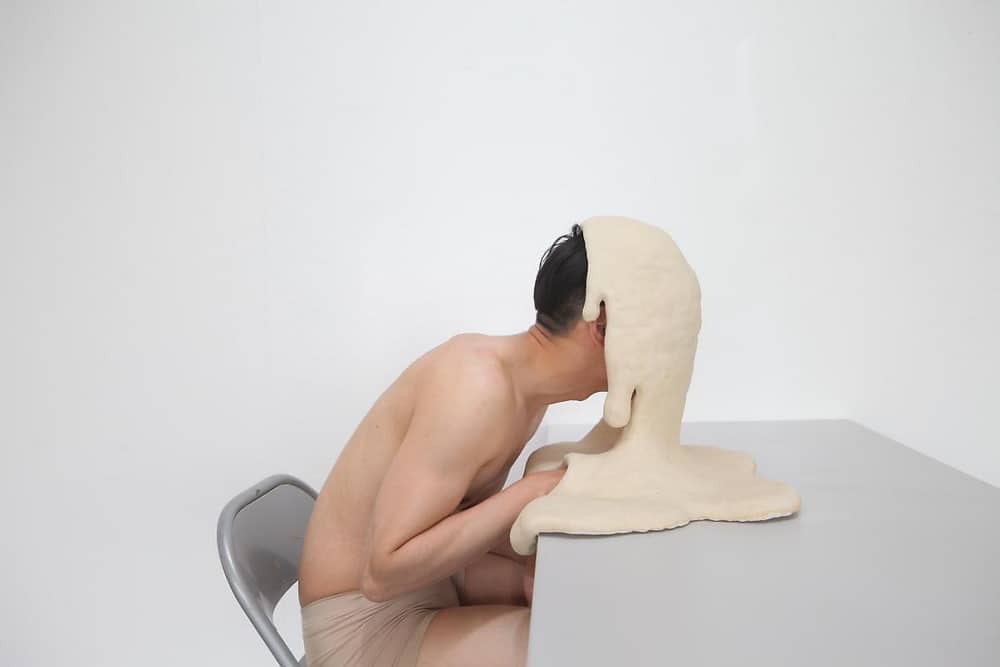
Inup Park, Emotions (loneliness, laziness, pressure), made in Seoul, Gyeonggi International Ceramic Biennale, 2015, South Korea
I create works about human feelings, because I believe that feeling has the purest and the strongest power. The human body can show feeling most effectively, so I make works which I put on my body or which are connected with my body. Although it is true that ceramics is not a very good material to be put on my body. I can create really great feeling when I use its weight, fragility and hardness. I feel that the world is pressuring me hard. I think this kind of feeling matches the nature of ceramics as it is heavy and cold. Emotions (loneliness, laziness, pressure) reflects the stresses I was under for such reasons as my prospects after graduation, my age, my financial status, and the like. I borrowed part of my body to materialise the laziness and loneliness inside of me through the piece. After all, it is out body that shows human emotions most casually but in confidence.
Juree Kim
- Juree Kim, Landscape, clay, water, 400 x 400 x 50cm, Gyeonggi International Ceramic Biennale, 2015
- Juree Kim, Landscape, clay, water, 400 x 400 x 50cm, Gyeonggi International Ceramic Biennale, 2015
- Juree Kim, Landscape, clay, water, 400 x 400 x 50cm, Gyeonggi International Ceramic Biennale, 2015
- Juree Kim, Landscape, clay, water, 400 x 400 x 50cm, Gyeonggi International Ceramic Biennale, 2015
- Juree Kim, Landscape, clay, water, 400 x 400 x 50cm, Gyeonggi International Ceramic Biennale, 2015
- Juree Kim, Landscape, clay, water, 400 x 400 x 50cm, Gyeonggi International Ceramic Biennale, 2015
- Juree Kim, Landscape, clay, water, 400 x 400 x 50cm, Gyeonggi International Ceramic Biennale, 2015
- Juree Kim, Landscape, clay, water, 400 x 400 x 50cm, Gyeonggi International Ceramic Biennale, 2015
- Juree Kim, Landscape, clay, water, 400 x 400 x 50cm, Gyeonggi International Ceramic Biennale, 2015
The house that I built are in the area of redevelopment in Korea. Soil is a symbol of life as material. Out of the soil it is circulated back into the soil principle no different from Buddhism. Also, I was influenced by Eastern philosophy overlooking the water. I read the book of Confucius and Lao-tzu’s thoughts on water. My work is an important medium in the water to complete the task. When it is completed, after much work, it is already the starting point of breaking up. I can not intervene into the progress once the clay joins the water. From that point on, the work unstoppably progresses by counteracting between. Water has two faces; one is giving life to my work. And the other is destroying, to complete the work. In the progress, water becomes muddy water, and clay becomes flexible loosing its the original shape. They complete their self-denial by becoming one.














